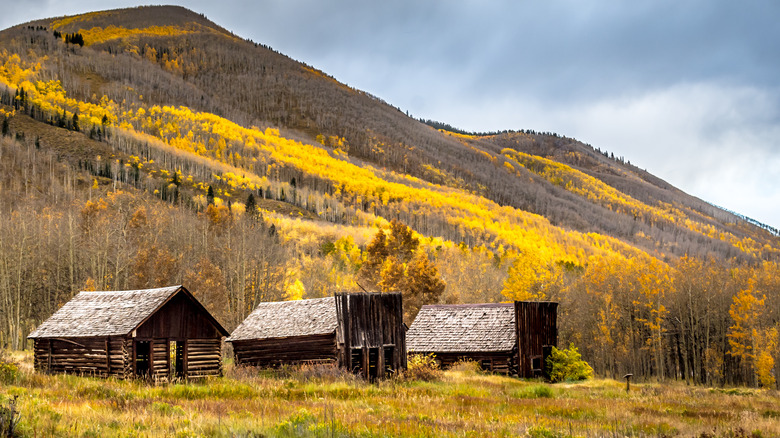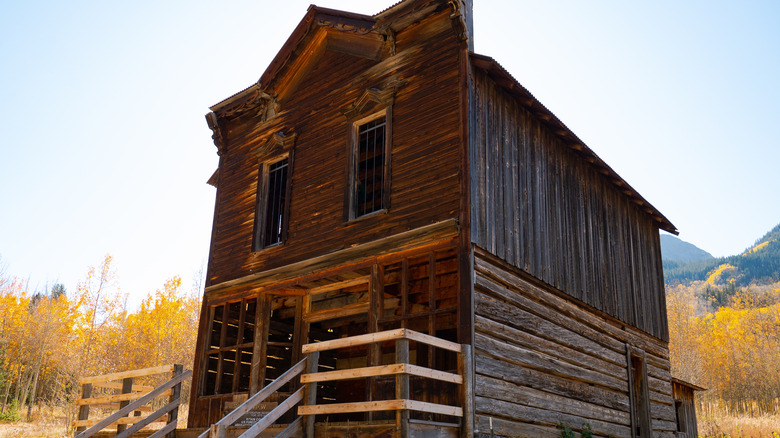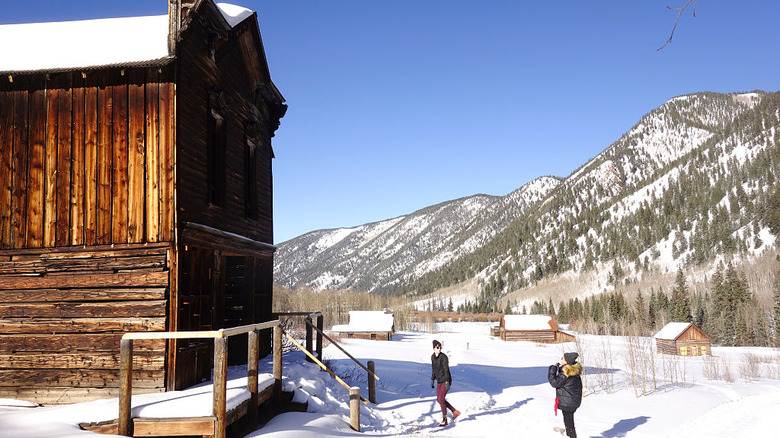Mountain Views And Mystery Make This Once-Booming Colorado Ghost Town A Worthy Visit
Believe it or not, there are things travelers can do in and around Aspen, Colorado, on a budget. It would be understandable, however, if you didn't have $5 admission to a nearby ghost town on your bingo card. Aspen has ranked as America's most expensive vacation destination in at least two separate analyses, per CNBC and Forbes. It's where some go for a ski holiday once they've made their fortune, but there was a time when it was the other way around, and people came to this part of Colorado hoping to strike it rich.
Ashcroft Ghost Town is a remnant of that time. The town, located 12 miles outside Aspen, initially benefitted from the silver mining boom when it first sprang up in 1880. Four years earlier, Colorado had become a U.S. state while America was celebrating its 100th birthday. (This earned Colorado its nickname, the Centennial State.) The state's oldest residents, the Ute people, were forced off their land and into reservations as the miners moved in, with Ashcroft's population eclipsing Aspen's for a time.
At the height of its boomtown years, Ashcroft had 16 to 20 saloons, which catered mostly to single men looking for diversion outside the mines. Yet its fortunes and the liquor supply soon ran dry as the silver in Ashcroft turned out to be mere surface deposits. By 1912, the town's population of 2,000 had shrunk to 50. In 1939, its last resident died off, and Ashcroft became a ghost town, like so many others in Colorado. Despite that, you can still visit what's left of the town and see history come alive against a beautiful mountain backdrop.
Ghosts of Ashcroft
Tucked away in Castle Creek Valley, in the heart of White River National Forest, Ashcroft Ghost Town is also listed on the National Register of Historic Places. During the summer, when the town is surrounded by green trees, a docent from the Aspen Historical Society is on hand to guide weekend visitors. The docent clears out in late September, whereupon Ashcroft becomes a true ghost town again. You can still visit it, and in fact, Ashcroft could be most scenic around that time, as the aspen trees turn a brilliant shade of yellow. However, you'll be on a self-guided tour, and you'll be on your honor to leave $5 in the admission box for every adult in your group.
It wouldn't be a proper ghost town without a haunted hotel. Among the nine surviving buildings in Ashcroft — which include a post office and the Blue Mirror Saloon — there is indeed a two-story hotel where some visitors have felt a ghostly presence, according to local legend. While certain buildings are closed off with signs like "Private Ghost Cabin" and "No Entry," you can step inside the hotel and even poke around upstairs until you get bored or see a miner's apparition (whichever comes first).
Ashcroft is free to enter for anyone under 18, and it has interpretive signs posted to explain the town's history so you're not just wandering around looking at abandoned buildings. This gives it the feel of an open-air museum at times. With a vivid imagination, it might hold a mysterious quality, too, if you come upon the remains of this deserted mining settlement when no other people are around.
The off-season, Pine Creek Cookhouse, and Aspen
At an elevation of 9,500 feet, Ashcroft Ghost Town sees its fair share of snow in winter. This makes it trickier to access unless you come prepared with tire chains and snowshoes. Through the Aspen Center for Environmental Studies, you can arrange for a snowshoe tour of the town and Castle Creek Valley. Ashcroft Adventures, located near Pine Creek Cookhouse at the end of Castle Creek Road, also offers tours along with rentable equipment for cross-country skiing.
The section of road past Ashcroft closes in winter, but guests of Pine Creek Cookhouse have the unique option of taking a sleigh ride to the restaurant. When the road is open, Aspen Peak Transportation provides shuttles from downtown Aspen to the Pine Creek Cookhouse as well. In both cases, it's expensive enough to offset the budget-friendly appeal of Ashcroft, so these might be better options if you're on a luxury ski vacation to Aspen and can afford a side trip in the same price range.
Spring isn't necessarily the best time to visit Ashcroft since the annual snow thaw can leave the area muddy, while the trees are still brown. That said, March may be the perfect time to go skiing in Aspen, which is also a popular Western U.S. destination for swimming adventures in summer. Famous sights like the Maroon Bells mountain peaks are lovely any time of year, so if you're in Aspen for the off-season, you might as well hit up Ashcroft Ghost Town during its on-season.


